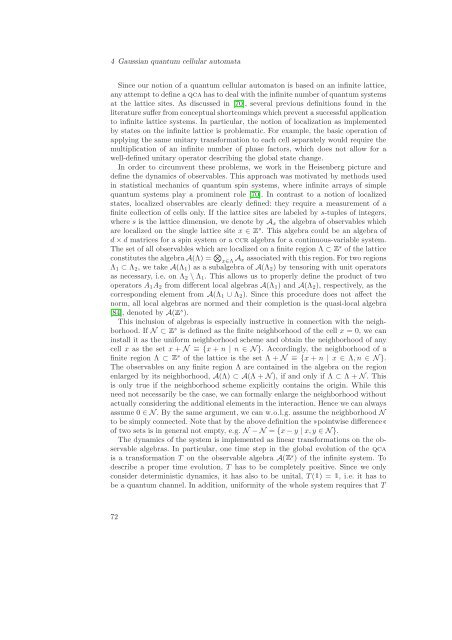Quantum Information Theory with Gaussian Systems
Quantum Information Theory with Gaussian Systems
Quantum Information Theory with Gaussian Systems
You also want an ePaper? Increase the reach of your titles
YUMPU automatically turns print PDFs into web optimized ePapers that Google loves.
4 <strong>Gaussian</strong> quantum cellular automata<br />
Since our notion of a quantum cellular automaton is based on an infinite lattice,<br />
any attempt to define a qca has to deal <strong>with</strong> the infinite number of quantum systems<br />
at the lattice sites. As discussed in [70], several previous definitions found in the<br />
literature suffer from conceptual shortcomings which prevent a successful application<br />
to infinite lattice systems. In particular, the notion of localization as implemented<br />
by states on the infinite lattice is problematic. For example, the basic operation of<br />
applying the same unitary transformation to each cell separately would require the<br />
multiplication of an infinite number of phase factors, which does not allow for a<br />
well-defined unitary operator describing the global state change.<br />
In order to circumvent these problems, we work in the Heisenberg picture and<br />
define the dynamics of observables. This approach was motivated by methods used<br />
in statistical mechanics of quantum spin systems, where infinite arrays of simple<br />
quantum systems play a prominent role [70]. In contrast to a notion of localized<br />
states, localized observables are clearly defined: they require a measurement of a<br />
finite collection of cells only. If the lattice sites are labeled by s-tuples of integers,<br />
where s is the lattice dimension, we denote by Ax the algebra of observables which<br />
are localized on the single lattice site x ∈s . This algebra could be an algebra of<br />
d × d matrices for a spin system or a ccr algebra for a continuous-variable system.<br />
The set of all observables which are localized on a finite region Λ ⊂s of the lattice<br />
constitutes the algebra A(Λ) = <br />
x∈Λ Ax associated <strong>with</strong> this region. For two regions<br />
Λ1 ⊂ Λ2, we take A(Λ1) as a subalgebra of A(Λ2) by tensoring <strong>with</strong> unit operators<br />
as necessary, i.e. on Λ2 \ Λ1. This allows us to properly define the product of two<br />
operators A1A2 from different local algebras A(Λ1) and A(Λ2), respectively, as the<br />
corresponding element from A(Λ1 ∪ Λ2). Since this procedure does not affect the<br />
norm, all local algebras are normed and their completion is the quasi-local algebra<br />
[84], denoted by A(s ).<br />
This inclusion of algebras is especially instructive in connection <strong>with</strong> the neighborhood.<br />
If N ⊂s is defined as the finite neighborhood of the cell x = 0, we can<br />
install it as the uniform neighborhood scheme and obtain the neighborhood of any<br />
cell x as the set x + N ≡ {x + n | n ∈ N }. Accordingly, the neighborhood of a<br />
finite region Λ ⊂s of the lattice is the set Λ + N ≡ {x + n | x ∈ Λ, n ∈ N }.<br />
The observables on any finite region Λ are contained in the algebra on the region<br />
enlarged by its neighborhood, A(Λ) ⊂ A(Λ + N), if and only if Λ ⊂ Λ + N. This<br />
is only true if the neighborhood scheme explicitly contains the origin. While this<br />
need not necessarily be the case, we can formally enlarge the neighborhood <strong>with</strong>out<br />
actually considering the additional elements in the interaction. Hence we can always<br />
assume 0 ∈ N. By the same argument, we can w.o.l.g. assume the neighborhood N<br />
to be simply connected. Note that by the above definition thepointwise difference<br />
of two sets is in general not empty, e.g. N − N = {x − y | x, y ∈ N }.<br />
The dynamics of the system is implemented as linear transformations on the observable<br />
algebras. In particular, one time step in the global evolution of the qca<br />
is a transformation T on the observable algebra A(s ) of the infinite system. To<br />
describe a proper time evolution, T has to be completely positive. Since we only<br />
consider deterministic dynamics, it has also to be unital, T( ) = , i.e. it has to<br />
be a quantum channel. In addition, uniformity of the whole system requires that T<br />
72
















